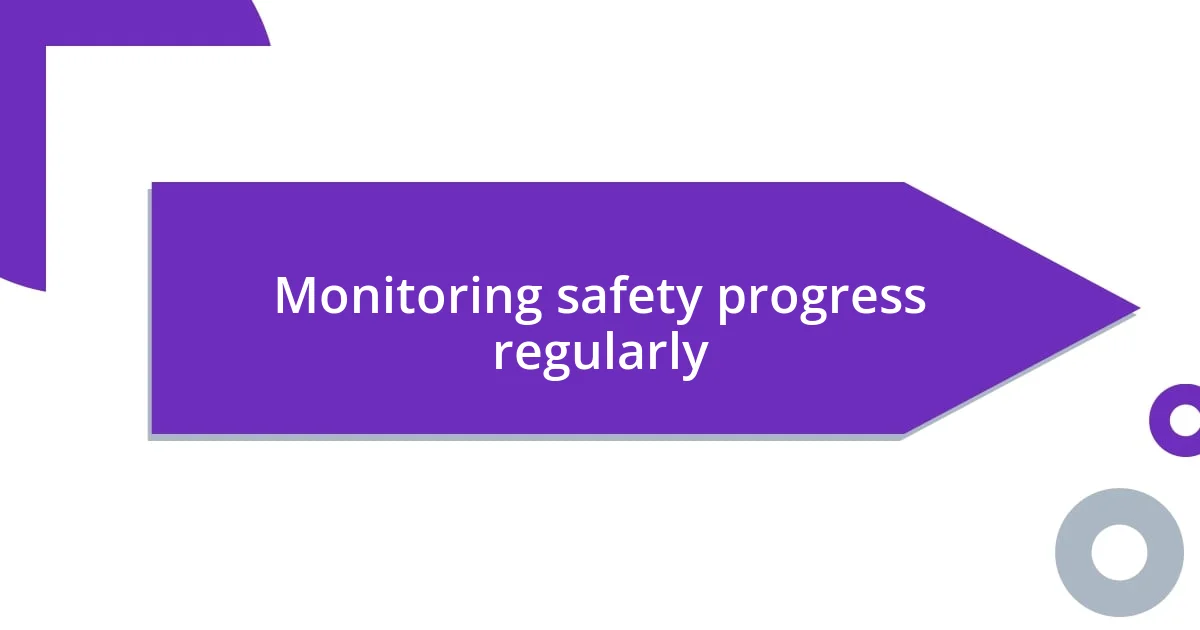Key takeaways:
- Effective safety practices start with awareness and open communication within teams, encouraging discussions about risks and near-miss incidents.
- A well-rounded safety action plan should incorporate goals, responsibilities, resources, timelines, and evaluation procedures, engaging the entire team for better adherence.
- Continuous monitoring and evaluation of safety measures, utilizing both data-driven insights and open feedback, fosters a culture of safety and promotes ongoing improvement.

Identifying safety challenges
Identifying safety challenges often begins with being aware of your surroundings. I remember walking through a construction site for the first time. What struck me was how easy it was to overlook potential hazards hidden in plain sight. Are we truly observing the environment, or are we just moving through it on autopilot?
As I delved deeper into safety protocols at work, I realized that communication plays a crucial role in identifying risks. One time, a colleague shared a near-miss incident that could have escalated into a serious accident. This experience reminded me that when we openly discuss challenges, we uncover not just the visible dangers but also the underlying issues that may have led to them. How often do we sit down with our teams to converse about what concerns us?
Reflecting on various scenarios, I’ve noticed that emotional responses often indicate areas of concern. For instance, I observed a team member who was unusually nervous during a drill, which prompted me to investigate further. That heightened anxiety often reveals a gap in understanding or preparedness. Have you ever paused to consider what your gut feeling could be telling you about the safety challenges around you?

Understanding risk assessment methods
When approaching risk assessment methods, I find it essential to understand that each method has its own strengths and weaknesses. For example, qualitative assessments provide valuable insights but may lack the precision of quantitative methods. During my time in safety management, I remember relying heavily on interviews with team members to gauge risks—it felt personal, yet it sometimes missed broader patterns.
In contrast, quantitative risk assessments can reveal statistical trends that qualitative methods may overlook. I once organized a workshop where we used data to address safety incidents from previous months. The analytical approach helped us recognize patterns we hadn’t considered, and it was surprising to see how visuals of the data sparked conversations about common risks.
Ultimately, combining both qualitative and quantitative methods can provide a comprehensive view of risks. I often encourage teams to blend personal experiences—like a near-miss incident shared by an employee—with data analytics. This dual approach not only enriches the assessment but also fosters a culture of safety awareness within the team. How are you currently balancing these methods in your own assessments?
| Risk Assessment Method | Characteristics |
|---|---|
| Qualitative | Focuses on personal insights and experiences, often through interviews or discussions. |
| Quantitative | Utilizes statistical data to identify and analyze risk trends, offering measurable insights. |

Developing a safety action plan
Developing a safety action plan requires a strategic, thoughtful approach that incorporates input from everyone involved. I recall working on a plan with my team after we had a close call during a routine task. The sense of urgency and collaboration inspired us to outline actionable steps. It was illuminating to witness how different perspectives contributed to our understanding of potential risks and solutions.
Here’s a straightforward breakdown of what to include in your safety action plan:
- Goals and Objectives: Clearly define what you aim to achieve with this plan.
- Roles and Responsibilities: Assign specific tasks to team members, ensuring everyone knows their responsibilities.
- Resources Needed: Identify the tools, training, and materials required to effectively implement safety measures.
- Timeline for Implementation: Set deadlines to track progress and ensure accountability.
- Evaluation Procedures: Establish how you will assess the effectiveness of the plan regularly.
By engaging everyone in the process, I found that the plan not only became a document but a shared commitment to safety that resonated with the entire team. It’s easy to overlook the human element in these plans, but I’ve learned that fostering a sense of ownership leads to better adherence and vigilance. How involved is your team when creating safety protocols?

Implementing training programs effectively
Implementing training programs effectively hinges on understanding the unique needs of your team. From my personal experience, I’ve realized that one-size-fits-all training often falls flat. When we revamped our safety training, I invited team members to share what they specifically struggled with. This collaborative approach transformed our training sessions into dynamic conversations where everyone felt heard and valued. Have you ever considered how tailoring a program can lead to deeper engagement?
Moreover, utilizing various teaching methods greatly enhances training effectiveness. During a hands-on training session I led, we incorporated role-playing scenarios that mimicked real-life incidents. Watching my colleagues step into these roles not only helped them grasp the material better but also ignited a sense of camaraderie. This practical application really stuck with them, making safety protocols feel less like rules and more like a shared responsibility. How do you incorporate different methods in your own training programs to cater to diverse learning styles?
Finally, regular follow-up on training outcomes is crucial for continuous improvement. After implementing new training, I set aside time to gather feedback through informal discussions. It was eye-opening to hear their thoughts; sometimes, the training we believed was clear needed further clarification. This ongoing dialogue not only helps refine the training but also strengthens the culture of safety. Do you currently have a system in place to ensure that your training stays relevant and effective?

Monitoring safety progress regularly
Monitoring safety progress regularly has been one of the most effective measures I’ve implemented in my professional journey. Early on, I prioritized routine check-ins with my team to assess how well we were adhering to our safety protocols. These sessions weren’t just about ticking boxes; they turned into valuable conversations where we could share real-time experiences and identify any emerging hazards. Have you ever found that consistent dialogue can transform compliance into a culture of safety?
During one monitoring session, I vividly remember a team member sharing concerns about a seemingly minor safety concern. It turned out that their insights led us to reevaluate a process, ultimately preventing a potential accident. Grasping the importance of open communication reinforced my belief that monitoring safety isn’t a one-time task. It’s an ongoing commitment that evolves with the team and the environment. How often do you encourage your team to voice their thoughts on safety?
I’ve discovered that utilizing data-driven metrics can also significantly enhance our monitoring efforts. By tracking incidents, near-misses, and even positive safety behaviors, I could pinpoint trends and adjust our strategies accordingly. I found that creating a visual representation of our safety progress not only motivated the team but also highlighted our collective achievements. Does your team celebrate milestones in safety improvements to keep the momentum alive?

Creating a safety culture
Creating a safety culture starts with fostering trust and open communication among team members. I recall an instance where I decided to hold a casual lunch meeting dedicated solely to discussing safety concerns. It was fascinating to witness the team hesitantly opening up at first, but as we shared personal experiences, the atmosphere shifted. Listening to each other’s stories not only helped us identify potential hazards but also bonded us on a deeper level. Have you ever noticed how a simple conversation can pave the way for a more vigilant team?
Engagement is crucial in establishing a strong safety culture. One memorable moment for me was when I encouraged my team to brainstorm safety improvement ideas during a regular meeting. I was pleasantly surprised when they proposed a creative initiative—a safety ambassador program—where colleagues could nominate peers who exemplified safety best practices. This recognition not only empowered individuals but also instilled pride and personal responsibility towards safety. How do you motivate your team to take ownership of their safety roles?
As I observe the impact of our efforts, I’ve realized that leading by example is vital. I’ve made it a point to transparently share my own safety missteps—even the ones that made me cringe—as learning opportunities for all. By doing so, I noticed that my colleagues felt more comfortable discussing their own challenges, thus cultivating a culture where safety is prioritized without fear of judgment. Have you thought about how embracing vulnerability can strengthen your safety approach?

Evaluating outcomes and improvements
Reflecting on the outcomes of my safety initiatives has taught me the importance of continuous improvement. I remember the first time we analyzed our safety data after implementing new protocols. As I reviewed the numbers, I felt a mixture of pride and surprise; our incident rate had dropped significantly. It made me realize that even small adjustments could lead to substantial safety advancements. Have you felt that rush of motivation when your hard work pays off?
One key takeaway for me was identifying areas that still needed attention. After each evaluation cycle, I would gather my team for an open discussion to dissect our findings. I distinctly recall a session where we uncovered a recurring issue with our training program. This prompted a redesign that incorporated hands-on exercises, making the training more engaging. Isn’t it fascinating how a little insight can prompt such meaningful change?
Implementing feedback loops into our safety practices also proved invaluable. I initiated a system where team members could anonymously report their concerns or suggestions. Initially, I worried that the responses might be sparse, but the flood of ideas surprised me! The act of inviting input not only honed our safety protocols but also created a sense of ownership among my colleagues. How can you create a space for honest feedback in your team?














